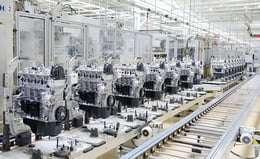Digitize Your Manufacturing Processes with APS Solutions
Martin Pahulje - October 26, 2021

Modern-day manufacturing is all about digitization. Through digitization, manufacturers can achieve greater speed, efficiency, and accuracy with lower costs and labor than traditional manufacturing processes. These benefits are further accelerated by advanced planning systems (APS), which help manufacturers to anticipate resource needs and maximize efficient use of materials, people, and machines. By digitizing your manufacturing processes with APS solutions, you can optimize your defining objectives in production, leading to higher quality, lowered manufacturing costs, and more.
Achieve Higher Quality
One of your primary objectives during the manufacturing process should be to produce and deliver high-quality products. The integrity of your business is dependent on the quality of your finished product, which begins in the manufacturing process.
A significant benefit of digitizing the manufacturing process is that you achieve an increased level of stability in your production lines. Digitized equipment is vastly more consistent than humans, with zero risk of human error. As a result, materials in the manufacturing process are more standard. Once an expectation of quality is set, it will be followed, allowing you to achieve higher quality products.
humans, with zero risk of human error. As a result, materials in the manufacturing process are more standard. Once an expectation of quality is set, it will be followed, allowing you to achieve higher quality products.
But, to obtain an enhanced level of stability, you need more than just digitization – you need a state-of-the-art planning system. Fortunately, APS solutions can provide this, in addition to being flexible and adaptive when events occur. With order scheduling and sequencing solutions, your APS solution can schedule orders without losing productivity or producing bottlenecks. These processes will be conducted while maintaining a high level of flexibility and ensuring stability throughout production, even in the event of high fluctuations in demand.
With optimized sequencing and fully utilized production lines, your manufacturing process will be significantly stabilized, resulting in a consistent and high quality of products. Even beyond the quality of products, your quality of manufacturing will improve. Digitization, particularly the APS solution, will drastically speed up manufacturing, allowing manufacturers to hit more aggressive deadlines without compromising their team members or products.
Reduce Manufacturing Costs
Another significant benefit of the production line stability created by APS solutions is reduced manufacturing costs. APS solutions enable manufacturers to use their resources - whether materials, people, or machines – more efficiently. Through planning and sequencing, manufacturers will know how many materials they need, which equipment should be used, and the most optimal times to produce specific products. As a result, no materials or labor are wasted, saving manufacturers significantly. In reducing waste, manufacturers substantially lower costs, maximizing the value of their production line.
These advanced planning capabilities also help manufacturers keep up with fluctuating demand, ensuring that they are not stuck paying for an excess of supply if demand drops. Additionally, manufacturers will not have to race to keep up with growing demand. Instead, their APS system will provide them with the insights to slot and schedule their production line according to accurately predicted demand, saving them from high and unpredicted manufacturing costs.
The stability created by APS solutions is also instrumental in reducing error. Errors can be costly if detrimental enough, especially if they are so drastic that an entire line must be reproduced. So, the more consistent a production line is, the fewer errors are made, and the more time and money are saved.
Connect with S&OP
While APS solutions alone can cultivate significant cost savings, connecting your APS-driven manufacturing processes with S&OP can create even higher savings. Many manufacturers face challenges including low flexibility and long delivery times, but with improved planning, both of these challenges can be overcome.
By connecting APS and S&OP, manufacturers receive accurate market forecasts with optimal ordering and planning data to create the most optimal manufacturing processes. Additionally, with capacity planning, manufacturers will obtain knowledge of the ideal capacities and flexibility to coordinate working time models. Simultaneously, logistics planners can determine the ideal flow of goods between plants and markets, ensuring that manufacturing processes are seamless and efficient.
The result of connecting with S&OP is then improved KPIs while enabling greater cost savings. More stable production through APS solutions allows production planners to operate with a clearer picture of their entire supply chain, thus improving the quality and granularity of the sales forecast. This, combined with enhanced transparency from S&OP processes, allows manufacturers to reduce opportunity costs, lead times from production to sales, and outbound logistics costs.
Open Up Silos
A significant challenge that arises in nearly every supply chain is data silos. As companies collect data to help improve processes, they can create a backup if it is not analyzed  promptly enough. This backup, or silo, can be problematic for manufacturers and production planners, as it can result in missed opportunities, lost revenue, expensive fees, and compromised production lines. For this reason, manufacturers must open up these silos, ensuring that data passes through at an efficient rate.
promptly enough. This backup, or silo, can be problematic for manufacturers and production planners, as it can result in missed opportunities, lost revenue, expensive fees, and compromised production lines. For this reason, manufacturers must open up these silos, ensuring that data passes through at an efficient rate.
With the right APS solution, data silos can be opened and avoided, ensuring that data moves around quickly and efficiently. As APS solutions are digitized, they can be automated, in which case data can be collected and analyzed without human interaction. If data can be processed at the same rate that it is collected, data silos can be opened up, ensuring that manufacturers and planners receive the data they need in a timely manner.
In receiving this data promptly, manufacturers can take advantage of opportunities such as market changes and adjust production quickly. This allows manufacturers to maximize the value of their production at the most opportune times, maximizing revenue and optimizing manufacturing processes.
Digitization Leads to Optimization
Digitization can drastically improve supply chain manufacturing processes, and once processes are digitized, manufacturers can adopt APS solutions. With APS, manufacturers can achieve higher quality, reduced manufacturing costs, open silos, and connect with S&OP.
Not only will this improve the flexibility and agility of your supply chain manufacturing processes, but it will also open doors to additional technologies and innovations. As a result, your manufacturing processes will be more efficient and productive than ever, and your company will be prepared for anything the future holds.
Click below to download our guide on Transformation of Manufacturing Processes
LATEST POSTS
- Understand Circular Economy in The Manufacturing Industry
- How Can Industry 4.0 IT Integration Be Achieved Smoothly?
- The Significance of Order Sequencing in Discrete Manufacturing
- How to improve your Supply Chain Management: The Power of Control Towers
- Optimizing Human Resource Scheduling in Manufacturing: A Technological Approach


